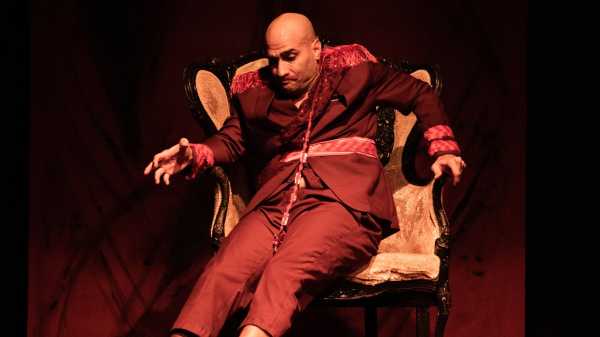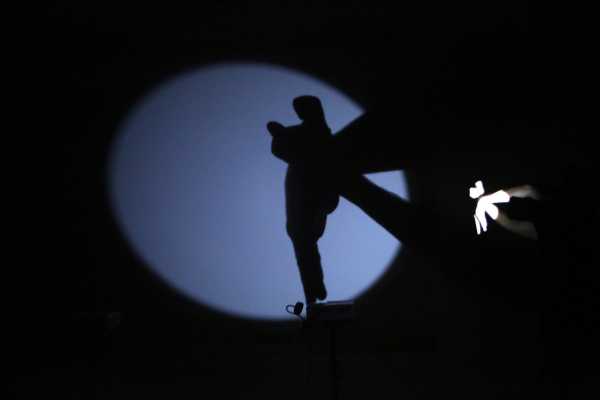
If you ask experimental theatre about its intentions, you’ll usually hear about either revolution or radicality—something explosive. Even the term “avant-garde” is salvaged from the battlefield: when you’re struggling against realism, pieces are supposed to resist or defy or transgress. But look. Everybody’s tired. Anything, including revolution, can be repurposed as comfort right now. Nostalgia isn’t just for conservatives—we are in the time of the derriere-garde, experimental hygge, the avant-cozy.
At least, we were this week. The experimental scene in New York found itself looking backward for its inspiration, finding solace in old movements, including gestures from childhood. In one corner (HERE Arts Center), Julia Jarcho’s company was performing “Marie It’s Time,” her dreamy response to Georg Büchner’s nineteenth-century play “Woyzeck.” In another, a trio of small companies performed “My Onliness,” an impish adaptation of text by a Pole, Stanisław Ignacy Witkiewicz, who changed the theatre a hundred years ago. The other shows I saw looked back all the way to the playroom—in two days I saw both a dance piece (John Jasperse’s eerie “Visitation”) and a multimedia event (Phil Soltanoff and Steven Wendt’s “This and That”) involving shadow puppetry—the kind you do with a bedsheet and a flashlight.

“This and That” is chock-full of pure forms being manipulated and juxtaposed.Photograph courtesy Maya Sharpe
I took the most delight from the wild-eyed “My Onliness,” possibly because I spent half of the show with a man-sized doll on my lap. The stuffed-fabric figure was being used as an effigy by a mathematician-witch trying to defy a mad king; when she hurled the floppy mannequin into the front row, its human counterpart likewise flung himself helplessly into our laps. Eventually, the persecuted monarch panicked and stashed the doll with me for safekeeping, and I watched the rest of the show sharing my chair with a body pillow in a crown.
What, was I going to refuse? No one could resist such a king, particularly because he’s played by the Rabelaisian director Daniel Irizarry, a capering theatrical creature with a goat’s appetite for heights. His titular Onliness is always bouncing up onto his “throne,” a gold-upholstered armchair jacked up five feet off the ground, boinging off the walls, dragging some character into the wings, or cajoling an audience member to do the torturing for him. The last time I saw Irizarry onstage, it was 2014, and he was playing the excitable, deranged Professor in an Ionesco comedy; the time before that, he was screaming his brains out as Ubu, Alfred Jarry’s coprophagic looney-tune usurper. The past several years have seen him steer his One-Eighth Theatre to the Polish writer and painter Witkiewicz (a.k.a. Witkacy), whose phantasmagorical cabarets of the nineteen-tens and twenties anticipated both the Theatre of the Absurd and sixties psychedelia by decades.
In “My Onliness,”a collaboration among One-Eighth, IRT Theatre, and the New Ohio Theatre, the playwright Robert Lyons pays tribute to a Witkacy text from 1921, “Gyubal Wahazar.” He hugely reduces it in both cast list and scope, turning it into an anti-authoritarian libretto with music by Kamala Sankaram. On the one hand, it is a hallucinatory nursery rhyme for adults, a barrage of surreal images and sounds. A man stands in a tub with the word “WRITER” scrawled on his belly, singing, “The new truth serum is completely worthless.” Later, when this Writer (Rhys Tivey) gets down in the dumps about state violence, a six-foot-tall lobster wipes his brow with a tender claw. Yet there’s a matrix in the mayhem: the nonsense king apes real authority—he wears elaborate magenta regalia with a sash and a martial red mustache—and Morbidita (Cynthia LaCruz), his adversary and subject, must approach him with a petition, carried high above her head in a garbage bag. Everyone can see that the king is bonkers. Surely someone could do something, but we’re all too busy laughing and doing shots (they give us shots!) to take responsibility.
“Aha,” I hear you cry, “a tyrant, both ingratiating and infantile? I bet he’s a metaphor!” But the moment you box up His Onliness into a recognizable symbolic package, the show busts him back out again. There’s certainly a junta-on-its-last-legs scent in the air, but Irizarry’s long dedication to this sort of hyperphysical work has more to do with its energetic vibrations and the contagious freedom imparted by his various Monster Heroes—His Onliness is a gonzo cousin to the Professor and Ubu. There’s no time for the specifics of political satire: the show’s dramaturgy is just one long wheeeee from its rollercoaster start to its sudden, operatic finish.
Witkacy’s original (subtitled “A Non-Euclidean Drama in Four Acts”) has different concerns, some of which I cannot follow—he wrote about a future government that operates in six dimensions, for instance—but I do know that it was an attempt at what he called the theatre of Pure Form. Kandinskian thought about composition and line had penetrated Witkacy’s thinking about performance: he believed in a new drama that could orchestrate movement, music, and “scenic internal construction” (rather than psychology or realistic characters) to communicate a metaphysical meaning. But does “My Onliness” reach that goal? Does it make the spectator feel as if he has just awakened from a dream, “in which even the most ordinary things had a strange, unfathomable charm”?
Charm, yes. Irizarry’s commitment to entertaining us takes care of that. But it took me a while to sense the show’s metaphysics—I listened and listened to the Lyons text and couldn’t figure it out. The answer, I think, lies in Irizarry’s production. “My Onliness” happens all around the audience, which sits in various orientations around the New Ohio’s tiny basement space. Whichever way we face, we can almost always see the text being translated into American Sign Language by one of two “mediums.” (Alexandria Wailes and Kailyn Aaron-Lozano are credited as the co-directors of “Onliness” ’s A.S.L.) The mediums, Malik Paris and Dickie Hearts, wear almost nothing but a collar of iridescent feathers; they wriggle like go-go dancers as they sign the text. Every now and then, though, some seeming non-actor in the audience—surprise!—will start up their own translation. Therefore, meaning, which seemed so elusive, is actually everywhere. Whether you understand it or not, whether you sense it or not, the air is thick with communication. Are you sure that the universe isn’t speaking? It can be so easy to misinterpret its signs as someone dancing.
Meanwhile, at the Chocolate Factory, a former machine shop in Long Island City, there’s a show that Witkacy would have loved. “This and That” is chock-full of pure forms being manipulated and juxtaposed. Staged amid a mess of equipment and projectors and lights on stands, it has the feeling of a demonstration hour, a sharing among friends. It is free of psychology and dialogue, at least in the conventional sense, a bare hour of “choreography” made just from light and shadow. The Polish catastrophist wouldn’t have recognized its mood, though—it’s sweet and gossamer fine.
The first portion of the short event consists of improvised live video feedback accompanied by recorded music—some jazz, a Bach cantata. Wendt manipulates electronic equipment (cameras, projectors, a laser pointer) in ways that create digital interference; the resulting feedback-generated shapes look like the animation in the most abstract sections of Disney’s “Fantasia.” We watch the wall, where pink towers build and crash, symmetrical fuzzy fractal shapes curl toward each other, little dots sizzle around like oil from a hot pan. In the second movement, Wendt goes lo(wer)-fi, making hand-shadow vignettes on the wall, again to music: a cowboy, his hat brim made from a pinkie and a thumb, sings to his dogies; a woman cradles her baby as she swings in a garden; a disco dancer snaps and struts to “Night Fever.” Wendt uses the circle of light like a camera’s eye, so we see figures at a distance, then in “closeup,” then they seem to dissolve into a black blob (his wringing hands), as if a projector light is burning through a film.
There’s a quality of retreat here—we’ve all been invited under the blanket fort to play. Soltanoff, one of our most interesting multimedia directors, treats his high-tech tools like toys, and Wendt also seems animated by a “let’s see what I can do” spirit, impressed by the simple, childish pleasure of making a rippling ocean by flexing his fingers. I found it utterly, blissfully, completely restful. If “This and That” reached for the metaphysical, I missed it. In fact, as I went back home on the subway, I scoured my mind for evidence that I had been to the theatre and found only a sort of bright, humming breeze. ♦
Sourse: newyorker.com